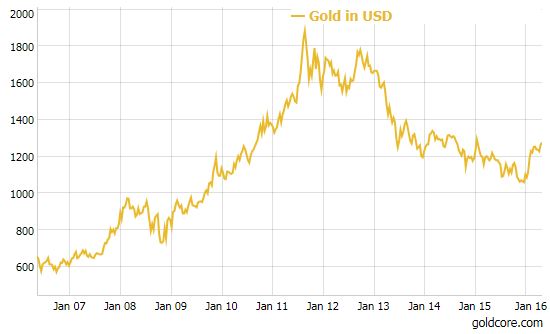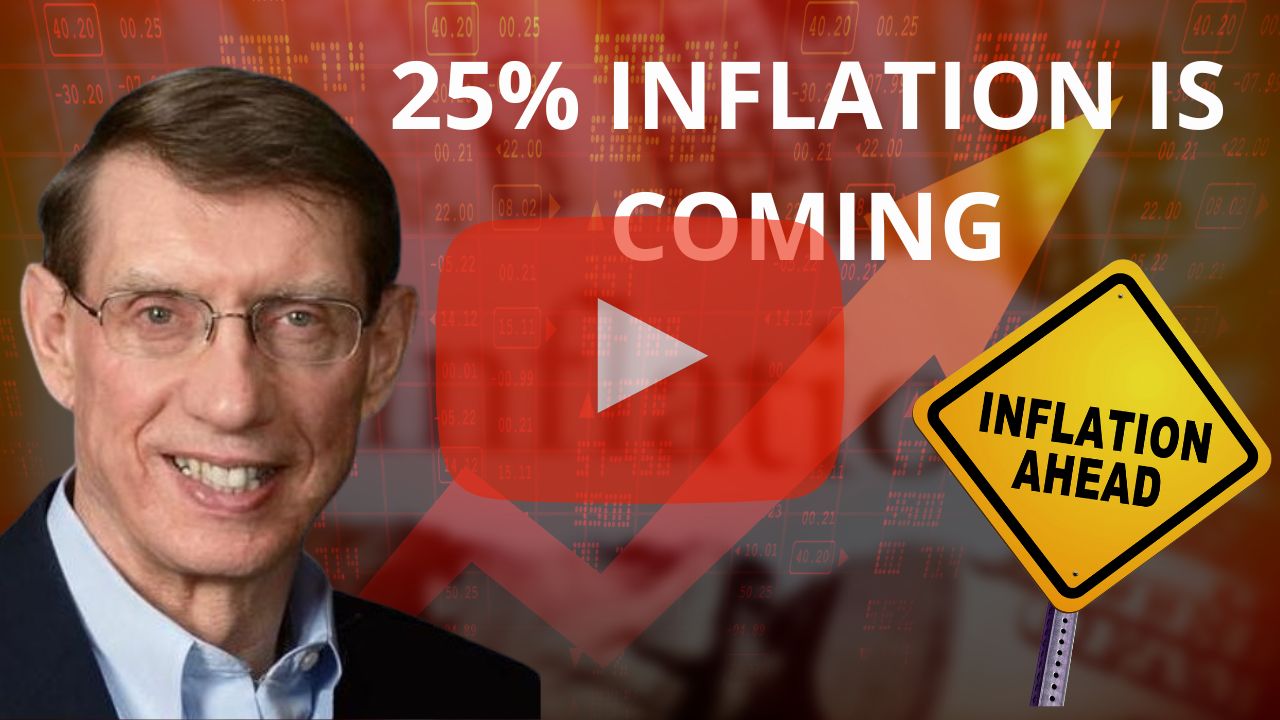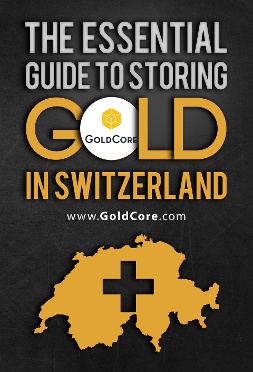James Rickards, economic and monetary expert, joined Bloomberg’s Francine Lacqua on Tuesday to discuss the gold “chart of the decade”, his new book “The New Case for Gold,” why gold is money and why gold is going to $10,000/oz in the coming years.
 Gold in USD – 10 Years (GoldCore)
Gold in USD – 10 Years (GoldCore)
Francine generously acknowledged how Rickards was “bullish on gold for quiet some time and actually you have been proven right … it is the chart of the decade”. She said that this “has to do with inflation expectations, it has to do with currency but it is really at the end of the day just a haven so people pile into it – as much as they do yen …”
GOLD IS MONEY
Jim responded that
“Gold is a form of money and not an investment. As money it competes with other kinds of money — the dollar, euro, yen etc.. They’re like horses going around a racetrack – place your bets but you have a subjective preference for money.
As investors are losing confidence in central banks … that’s what’s been going on and been clearly revealed. Central bankers have told me that they don’t know what they’re doing and they sort of make it up as they go along. They experiment.
President Evans of the Chicago Fed has said this and others have said it privately.
I spoke to Ben Bernanke and he described that everything he’s done was an experiment — meaning you don’t know what the outcome is.
So in that world where investors are losing confidence in central banks, gold does well.
Right now there are tens of trillions of dollars of sovereign debt with negative yields to maturity – bunds and JGBs..
Gold has zero yield.
Zero is higher than a negative 50 bps so gold is now the high yield asset in this environment.”
STOCKS HIGHER ON “FULL DOVE”
Regarding stocks, Rickards had this to say:
“Both gold and stocks are going up, and the reason stocks are going up is because Janet Yellen is going “full dove”. There’s nothing the stock market doesn’t like about free money. Plus negative interest rates might be on the table for next year.
That’s sort of bullish for stocks but it’s also bullish for gold.
Sometimes gold and stocks go up together and sometimes they don’t. There’s no long term correlation, but right now in a world of easy money and negative yields it’s good for both stocks and gold.”
GOLD AT $10K/oz
When asked for his price target for gold, Rickards says
“I have a technical level for gold, it is $10,000 U.S. per ounce. That amount gets bigger over time because it’s a ratio of physical gold to printed money. The amount of physical gold doesn’t go up very much, but printed money goes up a lot, so the dollar target goes up more over time because of all the money printing.
$10,000 U.S. per ounce is the implied non-deflationary price for gold. If you have to go back to a gold standard, or anything like it to restore confidence, that is the number you must have to avoid deflation.
So $10,000 per ounce is mathematically derived and is not a guess.”
INTEREST RATES and US ECONOMY
Rickards is asked what happens if Yellen tries to normalise rates and says
“If Janet Yellen begins to normalize then it would probably throw the U.S. into a recession. A 25 basis points hike in December threw the U.S. stock market into a 10% correction in the next two months.
The U.S. is hanging by a thread. It looks like first quarter GDP is going to come in at well below 1% according to the Atlanta Fed Tracker.
What’s the difference between -1% and 1%? Technically not much. One may be a technical recession and one is not, but growth is extremely weak. You don’t raise interest rates in a recession. You’re supposed to ease in a recession.
International spill over as well as the U.S. economy being fundamentally weak is the reason to not raise rates.
The time to raise rates was 2011 and that’s long gone. But two wrongs don’t make a right.”
SHANGHAI ACCORD and ‘SUPER MARIO’
“The Phillips Curve seems to have broken down — if it ever existed. The bigger play is the “Shanghai Accord” which came out of the G20 meeting in Shanghai, China in February 2016.
It’s like a secret Plaza Accord between the U.S. Fed, the Bank of England, the Peoples Bank of China, the European Central Bank and the Bank of Japan.
The evidence for a new secretive plaza accord is overwhelming. See here is the deal – China needs to ease. But the last two times China eased, August 2015 and December/January 2016, the U.S. stock market fell out of bed.
So how do you ease China without destroying the U.S. stock market?
So the answer is keep the dollar/yuan cross rate unchanged. Then ease in the U.S. dollar so that China goes along for the ride. At the same time tighten Japan and Europe, so you get a stronger yen and a stronger euro.
China is a larger trading partner for Japan and Europe than the U.S. is, so it’s a backdoor easing for China. Cross rates unchanged but China gets to ease.”
Lacqua wonders if Mario Draghi in the ECB would agree to that and Rickards concludes by saying that ‘Super Mario’ “is his favourite central banker”.
Watch the full interview here
Week’s Market Updates
Property Bubble In Ireland Developing Again
Silver Bullion “Momentum Building” As “Supply Trouble Brewing”
Cyber Fraud At SWIFT – $81 Million Stolen From Central Bank
Gold In London Vaults Beneath Bank of England Worth $248 Billion – BBC
Silver Prices Up 6% This Week and 25% YTD; Gold Up 1% This Week
Gold News and Commentary
Silver “will likely continue to be the surprise outperformer in 2016” said GoldCore (Reuters)
“Tempter tantrum in global markets today is quite worrisome” said GoldCore (Marketwatch)
Gold climbs after Fed, BOJ stand pat on policy (Reuters)
Gold powers higher as BOJ’s surprise inaction hurts the dollar (Mineweb)
Russia’s VTB aims to supply up to 100 tonnes of gold to China per year (Reuters)
Gross Warns Financial System Likely To Implode – (Bloomberg Video)
JP Morgan Sees Draghi as Buyer of Last Resort for Equities (Bloomberg)
Venezuela Doesn’t Have Enough Money to Pay for Its Money (Bloomberg)
America’s earnings recession just got worse (CNN)
Germany’s Merkel warns of risks to banks from low interest rates (Reuters)
Read More Here
Gold Prices (LBMA)
29 April: USD 1,256.60, EUR 1,106.45 and GBP 861.43 per ounce (To be updated)
28 April: USD 1,256.60, EUR 1,106.45 and GBP 861.43 per ounce
27 April: USD 1,244.75, EUR 1,100.79 and GBP 853.58 per ounce
26 April: USD 1,234.50, EUR 1,093.46 and GBP 847.28 per ounce
25 April: USD 1,230.85, EUR 1,094.08 and GBP 853.79 per ounce
Silver Prices (LBMA)
29 April: USD 17.35, EUR 15.29 and GBP 11.92 per ounce (To be updated)
28 April: USD 17.35, EUR 15.29 and GBP 11.92 per ounce
27 April: USD 17.34, EUR 15.34 and GBP 11.87 per ounce
26 April: USD 16.95, EUR 15.02 and GBP 11.64 per ounce
25 April: USD 16.86, EUR 14.98 and GBP 11.67 per ounce





